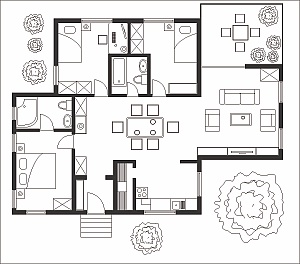 Learn how to read a floor plan. A floor plan is essential to the construction of a new property, although it can appear daunting at a glance due to the many symbols it contains. However, it is designed to present a clear layout of a home’s floor. An “open” floor plan refers to a home in which two or more traditional-use areas were joined to create a significantly larger space by removing some partition walls. According to some surveys conducted by the National Association of Home Builders, 32% of buyers say they desire a property with an entirely open kitchen-family room arrangement, while 45% wished for a fully open kitchen-dining area. In total, 54% of builders said their single-family home was constructed that way.
Learn how to read a floor plan. A floor plan is essential to the construction of a new property, although it can appear daunting at a glance due to the many symbols it contains. However, it is designed to present a clear layout of a home’s floor. An “open” floor plan refers to a home in which two or more traditional-use areas were joined to create a significantly larger space by removing some partition walls. According to some surveys conducted by the National Association of Home Builders, 32% of buyers say they desire a property with an entirely open kitchen-family room arrangement, while 45% wished for a fully open kitchen-dining area. In total, 54% of builders said their single-family home was constructed that way.
Important Factors When Reading a Floor Plan
The professionals at the Katie Zarpas Group can assist you with understanding this type of document if you’re looking to buy a new home. Here is a guide on how to read a floor plan, formerly called a “blueprint.”
How to Read Symbols
The walls of a home constitute one of the most important visual aspects of a floor plan. They are typically designated by parallel lines and can occasionally contain a pattern. A break in a wall signifies the presence of a window, door, or an opening between rooms. Sliding doors are often drawn partly open alongside a wall.
A set of rectangles typically indicate stairs and an arrow showing which direction they go relative to the floor in question is also included. Essential fixtures and appliances like sinks and refrigerators are often drawn almost exactly as they look.
Gauge Dimensions & Imagine Space
 “Dimension strings” are often utilized to identify doors, windows, and walls. They are usually drawn parallel to an architectural structure with 45° marks at each end to show where every measurement begins and ends.
“Dimension strings” are often utilized to identify doors, windows, and walls. They are usually drawn parallel to an architectural structure with 45° marks at each end to show where every measurement begins and ends.
In order to help you imagine how space on a floor can be used, an architect can include furniture like chairs, tables, and couches. Ceiling height and the placement of windows (i.e. how natural light streams into a room) can also give you an idea of how much room you can work with.
What Floor Plans Can’t Tell You
Nearly all floor plans include a scale that shows how much of a given space can fit on a piece of paper. According to diagramming software Edraw, ¼ inch-1 foot is a scale ratio frequently used today.
Nevertheless, there are certain things a floor plan normally doesn’t show, such as plumbing and electrical circuits. It also rarely displays how elevated a property’s floors are, so it may not show you how high up a deck is, for example. Therefore, it’s important to obtain as much information as possible about all of this.
Finding the Right Floor Plan for You
Ultimately, a floor plan should reflect your priorities as a homeowner. One NAHB preference survey revealed 29% of homebuyers (a majority) desire a home with 2,500 square feet or more. Aside from size and design style, however, you should also keep your budget in mind and factor in expenses such as heating and cooling and other general maintenance costs.
 Be sure to have a clear idea of how much outdoor space you are interested in (e.g., do you want a porch or a patio?). You should also decide whether you wish to have fixtures like ceiling fans installed, and how much space on each room’s walls you hope to use for paintings and other decorations.
Be sure to have a clear idea of how much outdoor space you are interested in (e.g., do you want a porch or a patio?). You should also decide whether you wish to have fixtures like ceiling fans installed, and how much space on each room’s walls you hope to use for paintings and other decorations.
Speak with a Seasoned Virginia Beach Real Estate Agent
Reach out to the luxury real estate professionals at the Katie Zarpas Group in Virginia Beach to learn more about the importance of a floor plan in the homebuying process.
Katie Zarpas worked as an assistant director in the entertainment industry for years before entering the luxury real estate business in 2005. She acquired many valuable connections during her former profession. The Hampton Roads Realtors Association gave Katie the Rookie of the Year Award after she sold 28 homes throughout her first year. She has also received the HRRA’s Diamond, Gold, and Platinum awards.
The Katie Zarpas Group handles listings in Virginia Beach and the surrounding areas, including Chesapeake, Portsmouth, Norfolk, and Suffolk. We constantly monitor local real estate market trends, and can thus help you estimate the value of your home with as much accuracy as possible. Call the Katie Zarpas Group today at (757) 685-4400 or contact us online for more information about our work. You’ll hardly find a more reliable real estate organization in Virginia.
